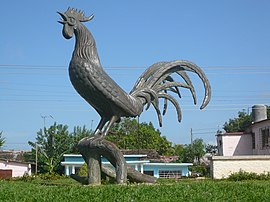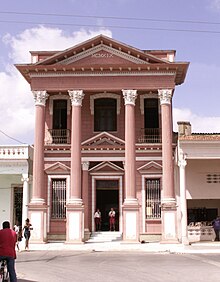Morón (Cuba)
| Morón | |
|---|---|
|
Coordinates: 22 ° 7 ′ N , 78 ° 38 ′ W
Morón on the map of Cuba
|
|
| Basic data | |
| Country | Cuba |
| province | Ciego de Ávila |
| City foundation | May 24, 1543 |
| Residents | 64,661 (2010) |
| Detailed data | |
| surface | 585.5 |
| Population density | 110 people / km 2 |
| height | 5 m |
| Waters | Caribbean Sea |
| prefix | 53-43 |
| Time zone | UTC -5 |
| The Rooster of Morón | |
Morón is a municipality and a city in the Cuban province of Ciego de Ávila . It is the oldest and second largest city in the province. Morón has 61,895 inhabitants, the municipality has an area of 615.5 km². Morón is the closest town to the tourist resorts of Cayo Coco and Cayo Guillermo .
The symbol of the city is the Rooster of Morón . At the southern entrance to the city (street from Ciego de Avila) there is now a 3 m bronze figure, which "crows" over loudspeakers at six in the morning and in the evening. Today's sculpture was created by Rita Longa in 1982. Before that, from 1955 to 1960, there was a figure by Armando Alonso in the same place.
geography
The municipality is located north of Ciego de Ávila and is bordered by the municipality of Bolivia in the east and by Chambas in the west.
To the north is the Atlantic Ocean with the offshore islands Cayo Coco and Cayo Guillermo . The coast is mostly covered with swamps. The country is largely flat with a few small hills in the north.
North of the city of Morón is the Laguna de la Leche with an area of 67.2 km².
The Carretera Norte crosses the city in a west-east direction, the road from Ciego de Ávila to Cayo Coco passes close to the city.
history
The first colonial settlement is dated to 1543. At that time, Don Luis de Almeida received the right to found a farm (Spanish hato : herd) from the city council of Sancti Spíritus . In addition to the Creole settlers, there were also seamen from Andalusia , Castile , Extremadura , Galicia and the Canary Islands . This first town center is said to have been a little further north than it is today.
The entire region with the offshore archipelago was initially very isolated and only underwent little development. The people lived in simple huts with the ground. Agriculture and animal husbandry were practiced as subsistence farming.
The sources are not uniform about the further settlement. There was a hermitage or chapel ( Ermita vieja ). In the oldest surviving baptismal register from 1774, she is named Nuestra Señora de la Candelaria de Morón . Around 1827 the entire settlement was relocated to the site of the current church due to constant flooding by the river 'El Roble'.
Morón has been an independent parish since 1852. Today's Catholic Church was consecrated in 1863. The building was used for military purposes several times. In Ten Years' War (1868) and War of Independence (1898) Spanish troops were billeted there. Some modifications that are still visible today are noteworthy, e.g. B. battlements in the tower and loopholes. Morón today has several churches of other religious communities that are also architecturally interesting (e.g. the Templo Metodista ). But these were only built later, after the arrival of further settlers.
From the 19th century, Morón benefited from the construction of the defense line ( trocha from Jucaro to Morón) and the infrastructure measures for the Spanish troops, and later especially as a connection point between two important railroad lines for the transport of sugar. From the second half of the 19th century, the population increased rapidly, and several striking buildings date from this period.
Morón was promoted to a 'villa' (larger settlement, market town) in 1869 and was promoted to town in 1921. Around 1920, at the same time as the construction of the new Norte railway line , six sugar mills were built in the Morón area.
On the offshore islands fishing and charcoal burning were the main industries. In the 1960s a road was built through the shallow Bahia de Perros to Cayo Coco. A Soviet air force base was located on the island. After 1990 a number of hotels were built on Cayo Coco . One of Moron's most famous sons was the musician Pío Leyva (Buena Vista Social Club).
tourism
Thanks to the nearby lakes Laguna de la Leche and La Redonda, Morón became a favorite destination for anglers and hunters very early on . The Centro Internacional de Caza y Pesca ( La Casona for short ) organizes activities for sport fishermen and water sports enthusiasts . Boat excursions on the Redonda with an ecological focus are also increasingly being offered.
Moron is now a popular destination for day trips from the tourist centers on the Cayos. For some time now, targeted measures have been taken to beautify the old city center, e.g. B. by renovating old facades along Calle Martí , or expanding and greening Parque Martí .
The city museum shows artefacts from indigenous culture, which were found during excavations in 1947, as well as other exhibits from the wars of independence and the revolutionary era. The building also offers a wide all-round view from a platform on the roof.
About 3 km southeast of Morón is the former Patria sugar factory . On the site of the old factory complex also has two well-preserved may Baldwin - steam engines be visited from the 1920s. A special round trip on open railroad cars has been booked by over 100,000 tourists since 2001.
The Norte train station in the city center is interesting for railway fans. The building from 1924 has been superbly preserved and is the second largest of its kind in Cuba after Havana. The central workshops of the Ferrocarriles del Norte company were located on the spacious railway area behind the station .
literature
- Subirats, Dr. Pedro G .: “Historia de Morón”, Imprenta Cultural SA, La Habana, 164 pages paperback, 1929. No ISBN available. Contains many photos and map reproductions.
Individual evidence
- ↑ 'Cumple Morón 467 años' - 467th anniversary of the city ( page no longer available , search in web archives ) Info: The link was automatically marked as broken. Please check the link according to the instructions and then remove this notice. on radiomoron.cu, accessed June 9, 2010 (span.)
- ↑ Article on the history of the town and the rooster of Morón ( Memento of the original from March 21, 2012 in the Internet Archive ) Info: The archive link was automatically inserted and not yet checked. Please check the original and archive link according to the instructions and then remove this notice. invasor.cu, accessed June 9, 2010 (span.)
- ↑ Short article on the city's history ( Memento of the original from April 18, 2016 in the Internet Archive ) Info: The archive link was inserted automatically and has not yet been checked. Please check the original and archive link according to the instructions and then remove this notice. invasor.cu, accessed June 9, 2010
- ↑ Website of the parish - there see section 'Historia de Morón', accessed on June 9, 2010 (Spanish)
- ↑ Representation of the old Municipio Moron on guije.com, u. a. historical map, population development, accessed June 13, 2010 (span.)
- ↑ Brief history of the city ( page can no longer be accessed , search in web archives ) Info: The link was automatically marked as defective. Please check the link according to the instructions and then remove this notice. on radiomoron.cu, u. a. with references to Dr. Subirats as the city's official historian, accessed June 13, 2010 (span.)
- ↑ Construction work in the old city center ( page no longer available , search in web archives ) Info: The link was automatically marked as defective. Please check the link according to the instructions and then remove this notice. on radiomoron.cu, accessed June 11, 2010 (span.)
- ↑ Excursion Tracking the footprints of sugar attracts foreign tourists ( page no longer available , search in web archives ) Info: The link was automatically marked as defective. Please check the link according to the instructions and then remove this notice. invasor.cu, accessed June 9, 2010
- ↑ Article about the architecture and historical value of the train station in Morón ( page no longer available , search in web archives ) Info: The link was automatically marked as defective. Please check the link according to the instructions and then remove this notice. radioenciclopedia.cu, accessed June 9, 2010 (span.)



